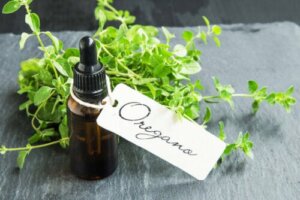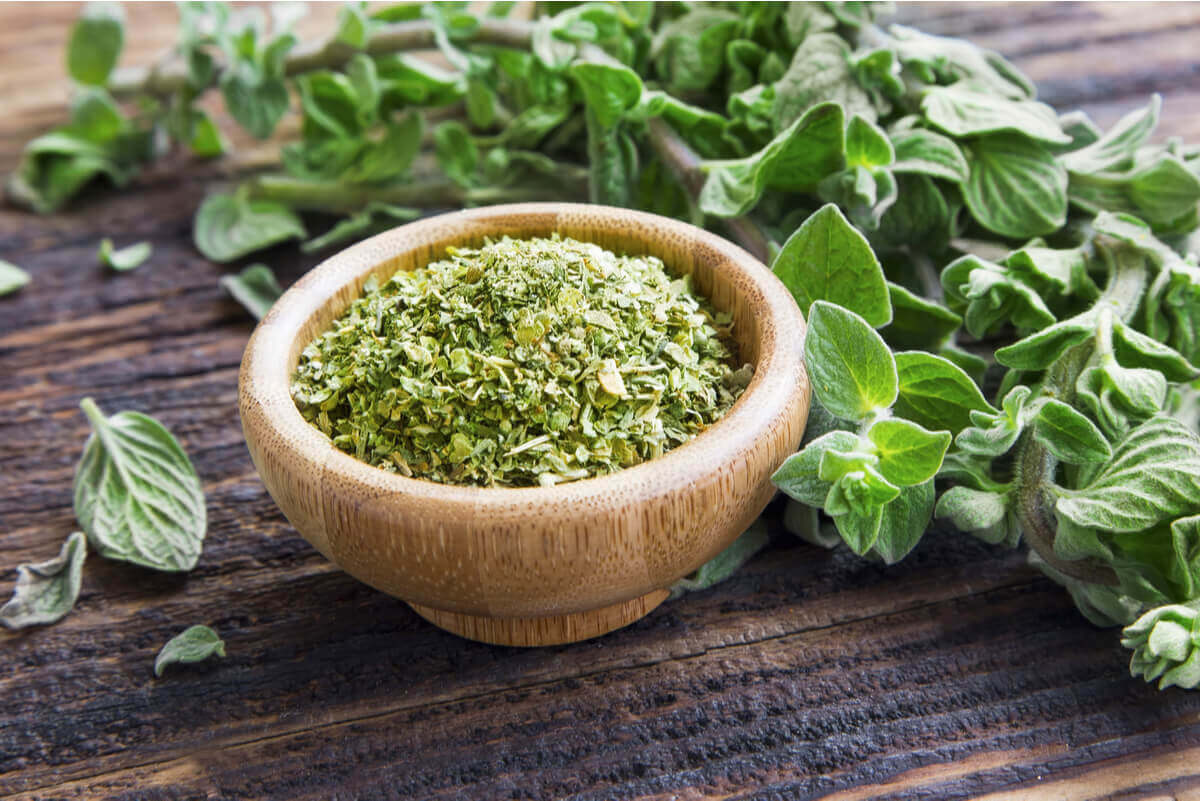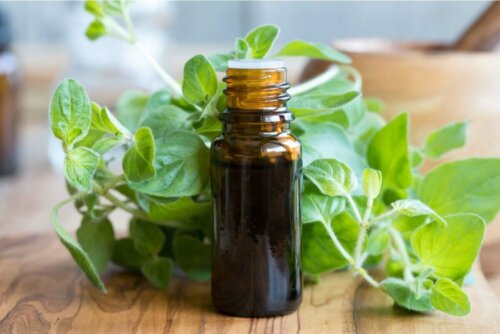How to Prepare Homemade Oregano Oil and its Benefits

Believe it or not, homemade oregano oil has benefits that range from helping fight bacteria to reducing inflammation. Did you about these wonderful benefits?
In this article, you’ll find out lots of interesting facts about the properties of this plant and how to prepare it.
Oregano is very popular in the kitchen, as it brings a pleasant flavor to many of our recipes. People usually use it directly in their food. However, it can also be used as an oil, in order to make the most of its benefits in the treatment of certain health conditions.
The benefits of homemade oregano oil
We can usually find oregano in most kitchens. In fact, it’s one of the most popular ingredients when it comes to seasoning recipes. However, what many people don’t know is that, besides providing flavor, this spice, when mixed with oil, has characteristics and properties that can be very beneficial to our health.
Read on and discover them!
Antioxidant potential
According to a study published in Oxidative Medicine and Cellular Longevity, the ethanolic extract of oregano has antioxidant activity. Because of this, some experts believe that this spice could have the potential to delay or prevent oxidation caused by free radicals, which are responsible for cellular aging.

Read also: Protect Your Respiratory System with this Oregano and Olive Oil Remedy
It may help fight bacteria
Oregano may also be a natural alternative to combat certain bacteria, according to an article in the International Journal of Odontostomatology. Thanks to the antibacterial activity of its carvacrol and thymol components, this plant may act against bacteria such as Staphylococcus aureus and Bacillus cereus.
It’s worth clarifying that it should only be used as a complement to pharmacological antibiotics, and not as a treatment for infections in its own right. There’s no evidence that its application alone is capable of eliminating bacteria.
It could help prevent viral infections
In addition to its antibacterial effects, according to research published in the Journal of Applied Microbiology, carvacrol contained in oregano may protect the body against some viral conditions such as norovirus. This is an infection that causes diarrhea, nausea, and stomach pain.
How to prepare it at home
Now that you know all about its main benefits, it’s time to get started! The process to prepare this home-made oregano oil is a very simple one. Besides, it’s a typically product you should always have on hand, so you’ll be able to use it in many different ways.
Ingredients
- 1/2 cup of oregano leaves (50 gr)
- 1/2 cup of olive, grapeseed, or almond oil (200 ml)
- A glass container with a lid
Preparation
- To start with, wash the oregano leaves and let them dry.
- When they’re dry, crush them with the help of mortar or similar utensil. This is to release all the plant’s properties.
- Place them in the glass container, which is where you’ll keep the mixture.
- Pour on the oil of your choice and cover the oregano leaves completely. Let it rest for a few minutes.
- Then, put on a pot of water to boil. Once it boils, turn off the heat and place the jar with the mixture inside it.
- Leave the jar in a bain-marie for about 10 minutes so that the oil and oregano combine.
- Remove the container from the water, cover it, and keep it for 2 weeks in a cool, dry place.
- After this time, strain the oil, and you’ll have some delicious homemade oregano oil ready to use.
- Don’t forget that, besides the medicinal use that we’ve described, this oil also adds a great taste to your recipes!
How to use oregano oil
Now that we’ve described how to make the oil, it’s time to explain how to apply or use it.
You can consume this oil or apply it directly to the area you want to treat. For example, for bacterial infections, you should dilute 3 drops of the preparation in a glass of water and consume it.
For muscular pains, rheumatism, and sprains, you can put some oil on your hands and massage the part of the body that’s giving you pain. If you wish, you can also include some essential oils that also provide similar benefits for these conditions.
In addition to this, many people claim that by inhaling it in a steam form, it may help to reduce flu symptoms. When you feel the typical discomfort of the flu or a common cold, use 3 to 6 drops of oil before meals, or use in a steam diffuser or a bowl of hot water. It’s safe to do this up to 3 times a day.

You may be interested in: The Differences Between Viruses and Bacteria
Some recommendations for oregano oil
Before you start taking oregano oil, you’ll need to ensure that it won’t be harmful to your health. Oregano oil is considered safe in most cases and the right dosage. However, there are certain risks for pregnant and lactating women or people with allergies to this condiment.
Also, excessive consumption could cause palpitations, nervous disorders, depression, and drowsiness. Remember that there are no miracle remedies, and it’s always best to consult a doctor if you suspect a serious problem.
All cited sources were thoroughly reviewed by our team to ensure their quality, reliability, currency, and validity. The bibliography of this article was considered reliable and of academic or scientific accuracy.
- Schovelin-H, Alexandra, & Muñoz-C, Marlene. (2018). Efecto Antibacteriano de la Infusión de Orégano ( Origanum vulgare ) sobre el Crecimiento in Vitro de Streptococcus mutans , 2015. International journal of odontostomatology, 12(4), 337-342. https://dx.doi.org/10.4067/S0718-381X2018000400337
-
Gilling DH, Kitajima M, Torrey JR, Bright KR. Antiviral efficacy and mechanisms of action of oregano essential oil and its primary component carvacrol against murine norovirus. J Appl Microbiol. 2014;116(5):1149-1163. doi:10.1111/jam.12453
- Coccimiglio, J., Alipour, M., Jiang, Z. H., Gottardo, C., & Suntres, Z. (2016). Antioxidant, Antibacterial, and Cytotoxic Activities of the Ethanolic Origanum vulgare Extract and Its Major Constituents. Oxidative medicine and cellular longevity, 2016, 1404505. https://doi.org/10.1155/2016/1404505
- Jiménez, María Cristina Rogles. Actualidad de los medicamentos a base de plantas para el tratamiento del dolor y la inflamación. Diss. UNIVERSIDAD COMPLUTENSE, 2017.
- Dufort, Julianne. Aceites esenciales: Una guía práctica para conocer las propiedades de los aceites esenciales y sus aplicaciones. Robinbook, 2017.
- Pérez, Rocío Mera Gallego. “Prevención de catarros y resfriados.” (2017).
- Llivichushca, Caivinagua, and Diana Alexandra. Factores de riesgo asociados a la atención de parto atendido por comadronas en domicilio en la parroquia Sígsig de la provincia del Azuay periodo septiembre 2017-febrero 2018. BS thesis. Universidad Católica de Cuenca, 2018.
- Vásquez Espeleta, Jorge Iván. “Actividad antibacteriana in vitro del extracto acuoso de Origanum vulgare L.(Orégano) sobre los Streptococcus mutans, distrito de Chimbote, provincia del Santa, departamento Áncash, 2018.” (2019).
This text is provided for informational purposes only and does not replace consultation with a professional. If in doubt, consult your specialist.








